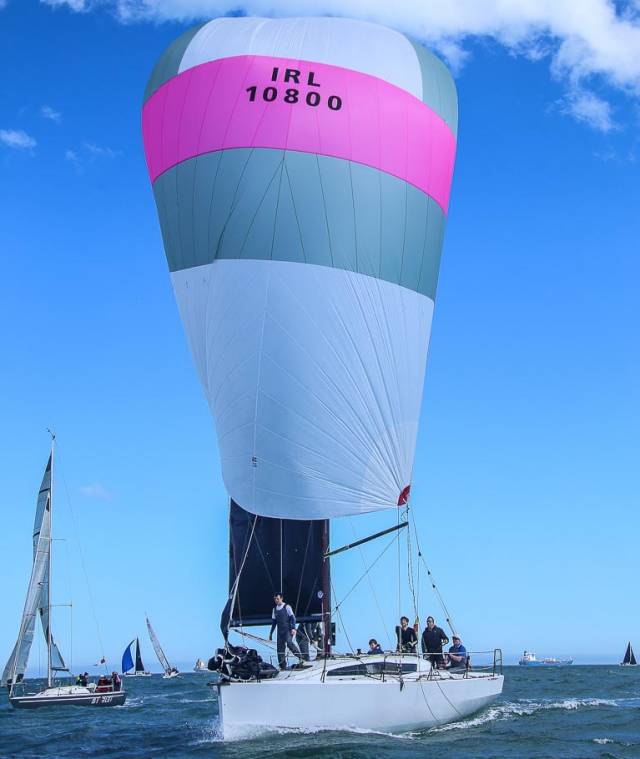Sailing Professional Mark Mansfield, who is a Racing Consultant with UK Sailmakers Ireland, goes through the different spinnaker sail options and how to set and control each of them. This is the latest in a series of information articles produced in conjunction with Irish Cruiser Racing Association (ICRA).
Up to about 15 years ago it was all very simple when you got around the top mark. You set your spinnaker. If it was windy, you likely had a heavy spinnaker with heavier cloth. You might even have had a reaching version if you had a fancy boat.
Now, that has all moved on. Spinnaker technology has completely changed, especially with the continued development of asymmetric spinnakers. These type of sails came from newer, faster planning boats, where it was found that the more closed leech symmetrical ('normal') spinnakers did not allow the boats to get up and plane easily.
However, asymmetric spinnakers are no longer all about planing. For cruisers, it was discovered that an asymmetric spinnaker on a sprit was easier to gybe, requiring less crew and also was particularly well rated on IRC. Yacht manufacturers like J boats jumped on that early and now virtually all J boat designs have sprits and asymmetric spinnakers, and do very well in racing.
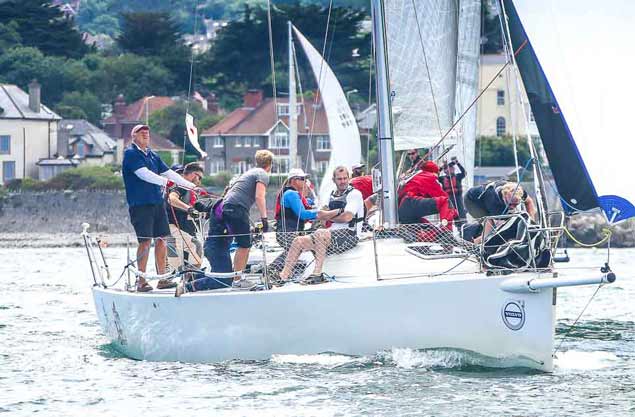 Article author Mark Mansfield (red hat) trimming an asymmetric spinnaker on a J109 in the 2017 Dun Laoghaire Regatta. Photo: Afloat.ie
Article author Mark Mansfield (red hat) trimming an asymmetric spinnaker on a J109 in the 2017 Dun Laoghaire Regatta. Photo: Afloat.ie
The J109 is an example of this. It uses only asymmetric spinnakers and these are very well suited for the design and as a result it wins regularly on IRC and in Ireland attracts great sailing with over 15 in the country presently.
What are the Spinnaker Options?
People are always getting confused by what spinnaker they need and the designation for it. You Hear of an A2, an S4 a Code 0. Many ask what do these stand for? The graph below explains this.
Asymmetric Spinnakers Designations
Code 0—Ultra reaching light air Asymmetric
1A Light Air Reaching Asymmetrical
2A Light Air Running Asymmetrical
3A Heavy Air Reaching Asymmetrical
4A Heavy Air Running Asymmetrical
5A Extreme Wind Asymmetrical
The code zero is a new addition in recent years. On IRC it rates as a spinnaker as its mid girth is over 75% of its foot. However, these are nearly genoa like shapes and are used for light air reaching, where a normal spinnaker could not be hoisted as the wind is too far ahead. So instead of reaching with your jib, you hoist this sail, which is likely at least twice as large as your Jib. Code 0 designs have moved on a lot in. Recent years and instead of the Old code 0’s which had flappy leeches, the new Code 0’s are much more efficient.
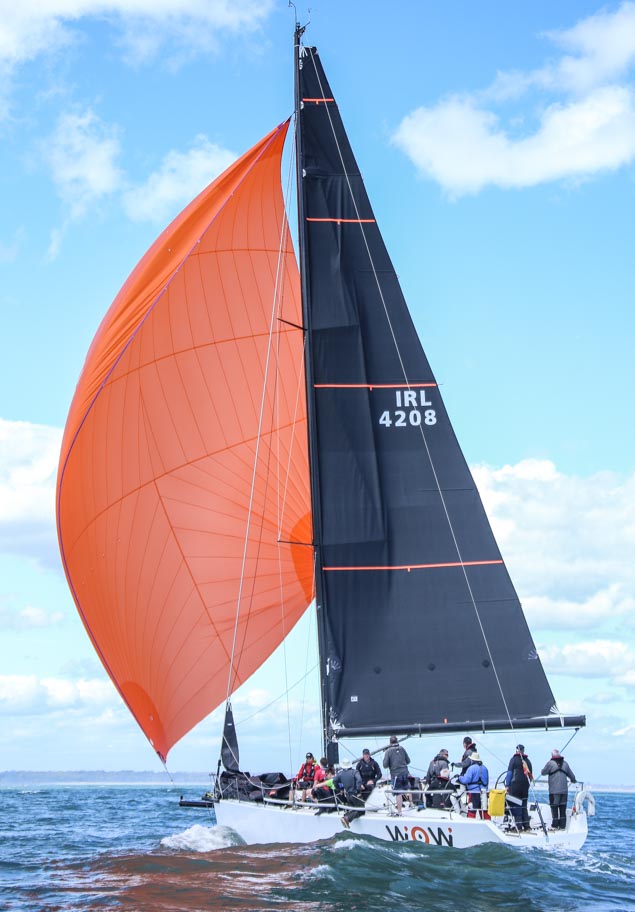 George Sisk's Farr 42 Wow with her new UK sails A 2 spinnaker projected to windward—tack line off a touch Photo: Afloat.ie
George Sisk's Farr 42 Wow with her new UK sails A 2 spinnaker projected to windward—tack line off a touch Photo: Afloat.ie
Symmetric Spinnakers--Designations
1S Light Air Reaching Symmetrical
2S Light Air Running Symmetrical
3S Heavy Air Reaching Symmetrical
4S Heavy Air Running Symmetrical
5S Extreme Air Symmetrical
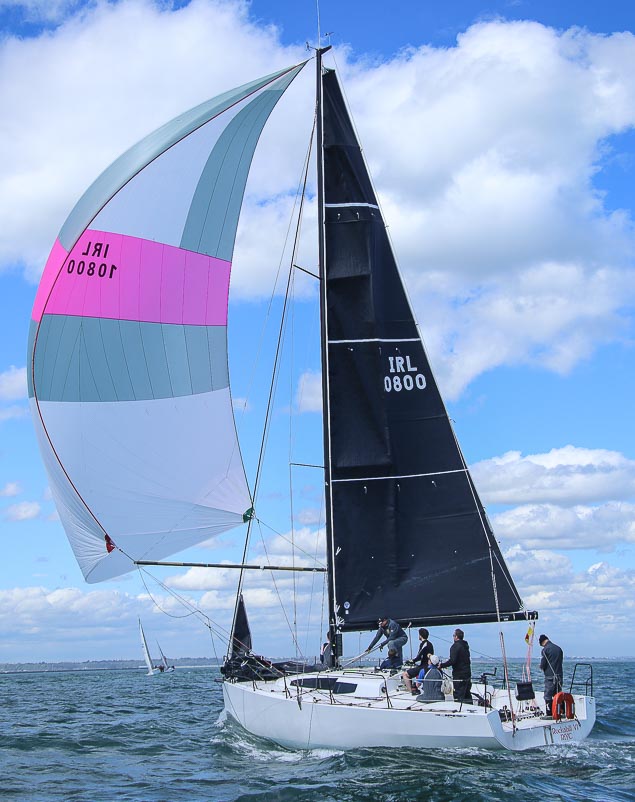 Paul O Higgins JPK 10.80 Rockabill V1 with her new UK sails S2 Symmetrical Spinnaker Photo: Afloat.ie
Paul O Higgins JPK 10.80 Rockabill V1 with her new UK sails S2 Symmetrical Spinnaker Photo: Afloat.ie
How to Set & Trim your Spinnaker
Asymmetric Spinnakers – Setting an Asymmetric spinnaker is pretty straightforward. First get the tack to the end of the sprit/bowsprit. If you have a mechanism like we have on UK sails asymmetrics, where there is a shockchord band built into the luffs, use this to stop the tack opening too early.
When the hoist is called, a quick bear off of the helm, bounce the chute up quickly, and even before it hits the top, the jib halyard should be released so that it drops a few metres initially. This then allows the head of the Asymmetric to fill quickly which drags the rest of the Asymmetric forward and it normally fills with a big whoosh. It is important that the sheet is allowed to spill out quickly until the moment that it just starts to curl, as without a quick spill, the boat is liable to become overpowered and round up. Once filled, the first thing I always ask is for the Other Spinnaker sheet to be loaded immediately on the other winch so that if I opt for a very early gybe, we are immediately ready. This is very important as often after rounding a top mark, it can get very crowded to weather with boats trying to go over the top of you and sometimes a quick gybe can be completed and you can exit the pack easily.
Gybing an Asymmetric—inside Ensure you take in all the slack on your lazy sheet. As the boat goes into the gybe ease the old sheet, but do not let it go completely as the clew will get too far forward and then when you gybe it can easily twist. Best to hold the sheet until you feel the pressure coming on the new sheet. Normally one or two crew will manhandle the new sheet around the front of the forestay. The sheet trimmer will need to sheet on a good bit initially, then when it fills, a big release is necessary to get it out.
Gybing an Asymmetric—outside This is the best way if your sprit is quite short, as there may not be enough room to get it across between the forestay and the chute. It is slower however and if an inside gybe can be achieved, it is normally a better way to go. With an outside gybe, you just let the sheet go completely and flag the sail out in front. Then, when the boat is passed dead downwind, the new sheet is brought in. There will be a lot of sheet to come in though, and this can take some seconds where the spinnaker will not be filling. It is the best option if you are short crewed and in much bigger boats it is a safer bet with less chance of a wrap.
Trimming an Asymmetric
Running with an Asymmetric is quite difficult as if it is too deep, the spinnaker gets into the bad air of the main and collapses. It is important to try and get the spinnaker projected to windward and steady. Positioning your crew up by the shrouds, to windward will help this projection, as will a release of the tackline. My guide to how much tackline to release is to initially ease the tackline quite a lot, then wind it back in, while the trimmer keeps trimming the chute. The asymmetric spinnaker should rotate to windward as the tackline comes on, then there will come a point where it stops rotating to windward and goes the other way. That is normally when the tackline is in the correct position—just when it tries to go the wrong way.
Unlike a symmetric spinnaker, it is best not to have a permanent curl on the luff. I find that you always need to be trying to ease the sheet and when it curls, take the curl out. Very often you see a curl, you pull in one foot of sheet and the curl disappears, then you can release about four feet quickly till it curls again, then a foot back in. It must be a constant thing, happening all the time.
Likewise, the trimmer must be talking constantly to the helm. The trimmer, I often say, drives the boat downwind, the helm just turns the wheel and does what he is told. The trimmer needs to sense when the pressure is strong immediately and call the helm to bear away. Likewise if his sheet is getting slack, he must call the helm up. Getting deep downwind is an art and the trimmer is the artist. A quiet trimmer is rarely a good trimmer.
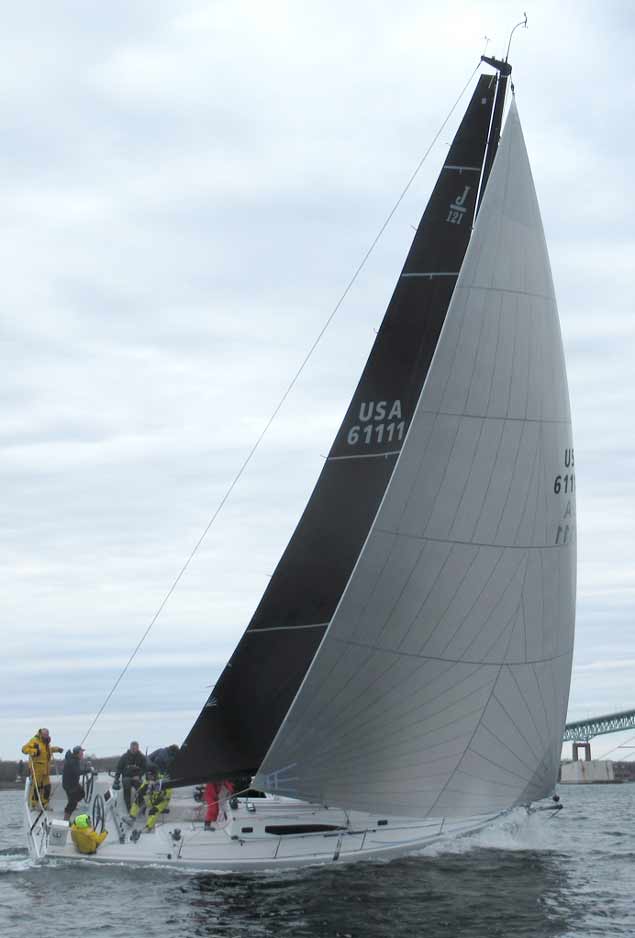 Jackhammer, the new J121 with her Uk sails Ireland code 0 showing how it can be carried up the wind range and sheeted very close
Jackhammer, the new J121 with her Uk sails Ireland code 0 showing how it can be carried up the wind range and sheeted very close
Dropping an Asymmetric
This can sometimes be a bit exciting, especially if you are reaching into the mark. If at all possible drop the spinnaker on what will be the new leeward side on the next hoist. Changing the gear from one side to another, while going upwind is very slow. Sometimes however , especially if coming in on a tight reach, there is no choice—you have to do a Leeward drop. This is generally to be avoided if possible as it is much more likely that you will put the chute in the water on a leeward drop.
It is much better to try and arrange your gybes to come in and be able to do a windward drop. With a windward drop, just get one or two crew all set up on the weather lazy sheet, make sure they are right back towards the shrouds as you want to get as much of the sail around the forestay as possible. Dump the tack line, pole out and spinnaker sheet at the same moment which should allow the spinnaker to flag easily out the front, then pull the windward sheet hard and make sure to get all the foot in quickly. Then down the hatch.
A leeward drop is a lot more difficult. It is best to have a retrieval line attached to the tack. This goes under the jib and above the lifelines. Have 2 crew braced and ready to pull this. Dump the pole, then throw some halyard and release the sheet at the same moment. The spinnaker should collapse, then the two braced people have to pull like mad to get it out of the water. The tackline is dumped at this juncture and the halyard is held until you see it in control, then progressively eased. Not for the fainthearted and this option should be avoided if at all possible.
Finally, there is a Mexican drop (sometimes called a Kiwi), where you are gybing at the bottom mark. The trick here is a wide rounding, a slow gybe, hold the spinnaker sheet tight on the leeward side until you gybe, then just leave the spinnaker collapse into the spreaders as you gybe(slowly, hopefully), then the halyard goes fully and the spinnaker is dragged down the windward side. It might sound complicated but it can be the safest choice to ensure it does not go in the water.
Symmetric spinnakers
Hoisting – Similar to an asymmetric, just set the pole up before you round, get deepish quickly, get the poll back early. Try and preset the sheet to a mark, so that when you hoist and bear off it fills immediately. Again, always we set up immediately for a gybe.
Trimming – Running downwind the clews should be level, However, often it is best to choke down the sheet to leeward to keep the spinnaker from skying. Once this is done, then the pole may not have to be raised on the outboard end too much. Always have the pole level to ensure max projection.
The weather luff should not over rotate too much over the line of the end of the pole. If you do, that will actually make the projected area smaller. Better to pull the pole aft as much as you can, keeping the weather luff nearly parallel to the mast, easing the sheet regularly but not so much that it rolls over itself.
When you gybe, try and get all the crew to move their weight to windward just as you gybe, that heels the boat to windward, helps the boat to bear off without a lot of helm movement. Then, once the main swings through, all the crew jump to windward, and this rocks the boat through the gybe. Also if the boat ends up then heeled to windward that keeps the spinnaker out on that side, until the pole is sorted. As a practice move, I often take off the pole altogether and the crew go through a series of gybes without a pole, using body weight to help the spinnaker move from one side to the other.
In strong winds, dead downwind, it is best to ease the pole a bit forward and overtrim the sheet to keep the spinnaker from swaying around. This will help the control. Also pull in the mainsheet a bit to prevent the Chinese type windward broach which is never pretty.
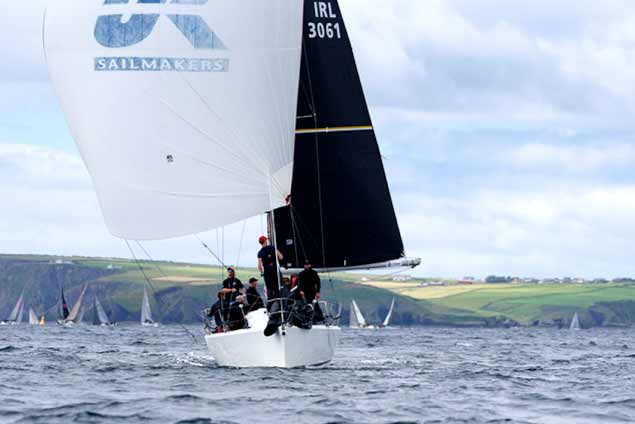 Rob Mc Connell's Fools Gold with her UK sails S2 spinnaker and Uni Titanium Main, on the way to winning Sovereigns week 2017
Rob Mc Connell's Fools Gold with her UK sails S2 spinnaker and Uni Titanium Main, on the way to winning Sovereigns week 2017
Is it best to go Asymmetric/Symmetric?
Faster, planing boats will always go asymmetric, as they can maybe double in speed when they plane, and it is easier to get on the plane with an asymmetric. With slower, displacement boats it is a more difficult choice.
You can, of course, have a combination of both, have symmetric sails for running, and Asymmetric sails for reaching. However, an Asymmetric sail sets best on a prod and if you have both a pole and a prod, the prod can't be any longer than the distance the pole extends out over the pulpit (STL measurement on IRC), unless you want to extend your STL at the cost of your rating. Most boats with symmetrical spinnakers who are competitive, will have at least one asymmetric spinnaker as well, normally an A3 for reaching.
The IRC rule gives an advantage in rating to a sprit only boat, as that boat is unable to pull back the sprit like you could with a symmetrical pole. As a result, for the same rating, you normally can get approximately 10% to 15% more spinnaker area with a sprit only boat. In light airs, when a boat with a pole has to heat up anyway and have the pole close to the forestay, then the sprit boat can go at the same angle and have maybe 15% more sail. Clearly, a win for the sprit boat. In medium winds, up to about 15 knots, the sprit boats, setting a nicely set modern asymmetrical A2 chute, can likely match a symmetrical boat downwind, as it can't go as deep, but it has more sail area. Above 15 knots, the poled out symmetrical boats come into their own, they can go virtually dead downwind, whereas the asymmetrical boats still have to stay maybe 15 degrees off dead downwind as if they go too deep, the asymmetric, sometimes in a second, just collapses as it gets bad wind from the mainsail.
Offshore though, the asymmetric finds a lot of favour, as unlike windward/Leeward racing, offshore racing often has a lot of reaching, and with the extra sail area that an asymmetric boat can carry for free, it has a great advantage reaching. Often you will see competitive boats completely change to a sprit mode for a race like the Round Ireland or Fastnet and then change their rating back to a symmetrical setup for inshore racing. It needs a lot of sails and a big bank account for that though as the spinnaker sizings would be different.
Crewing an asymmetrical boat is easier, especially handling the spinnakers. A symmetrical set up needs a very good bowman, otherwise there is real trouble in store. I am sure most of the good asymmetrical boats also have very good bowman, but even some inexperienced bowman on a sprit boat can get away with most hoists and drops.
There maybe a lot of choices nowadays and it can all be a bit confusing, but there is no doubt that having the right inventory of downwind sails will bring a big advantage.
All the best and fair sailing.
Mark Mansfield
Racing Consultant /Agent for UK sails Ireland
Ph 087 2506838
E mail—[email protected]
Other articles in the UK Sailmakers Ireland/ICRA 'How to...' Series:



























